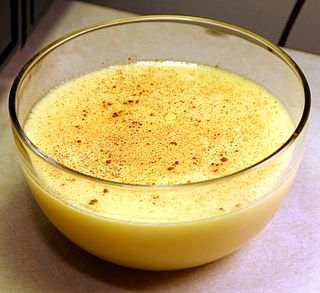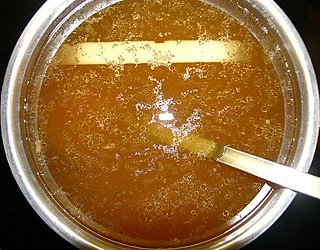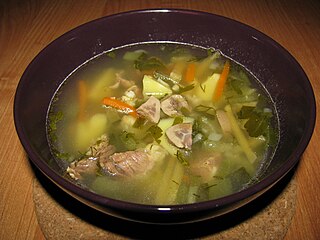
Chicken soup is a soup made from chicken, simmered in water, usually with various other ingredients. The classic chicken soup consists of a clear chicken broth, often with pieces of chicken or vegetables; common additions are pasta, noodles, dumplings, or grains such as rice and barley. Chicken soup has acquired the reputation of a folk remedy for colds and influenza, and in many countries is considered a comfort food.

Custard is a variety of culinary preparations based on sweetened milk, cheese, or cream cooked with egg or egg yolk to thicken it, and sometimes also flour, corn starch, or gelatin. Depending on the recipe, custard may vary in consistency from a thin pouring sauce to the thick pastry cream used to fill éclairs. The most common custards are used in custard desserts or dessert sauces and typically include sugar and vanilla; however, savory custards are also found, e.g., in quiche.

Tourin is a type of French garlic soup, also known as le tourin d'ail doux, or smooth garlic soup. Many regions have their own variations on the recipe. Typically, many recipes include as many as 20 cloves of garlic for a much stronger flavor. However other recipes include an equal measure of both onions and garlic to even out the taste. To prepare, the minced garlic are sauteed until soft and a simple roux is made by adding flour. Chicken stock or water is added to the mixture and is simmered over low heat to reduce. Egg whites are slowly drizzled in, not unlike egg drop soup, but whisked very rapidly to prevent large curds from forming. It is further thickened by tempering an egg yolk mixed with vinegar, which is then added to the soup.
Knödel or Klöße are boiled dumplings commonly found in Central European and East European cuisine. Central European countries in which their variant of Knödel is popular include Austria, Germany, Hungary, Poland, Romania, Serbia, Croatia, Slovenia, Slovakia, and the Czech Republic. They are also found in Scandinavian, Romanian, North-eastern Italian cuisine, Ukrainian and Belarusian cuisines. Usually made from flour, bread or potatoes, they are often served as a side dish, but can also be a dessert such as plum dumplings, or even meat balls in soup. Many varieties and variations exist.

Egg white is the clear liquid contained within an egg. In chickens it is formed from the layers of secretions of the anterior section of the hen's oviduct during the passage of the egg. It forms around fertilized or unfertilized egg yolks. The primary natural purpose of egg white is to protect the yolk and provide additional nutrition for the growth of the embryo . Egg white consists primarily of about 90% water into which about 10% proteins are dissolved. Unlike the yolk, which is high in lipids (fats), egg white contains almost no fat, and carbohydrate content is less than 1%. Egg whites contain about 56% of the protein in the egg. Egg white has many uses in food as well as many other uses.

Broth, also known as bouillon, is a savory liquid made of water in which bones, meat, or vegetables have been simmered. It can be eaten alone, but it is most commonly used to prepare other dishes, such as soups, gravies, and sauces.

Hollandaise sauce, formerly also called Dutch sauce, is an emulsion of egg yolk, melted butter, and lemon juice. It is usually seasoned with salt, and either white pepper or cayenne pepper.

Avgolemono or egg–lemon is a family of sauces and soups made with egg yolk and lemon juice mixed with broth, heated until they thicken. They are found in Greek, Arab, Sephardic Jewish, Turkish, Balkan and Italian cuisine.

Eggnog, also spelled egg nog or egg-nog, and historically also known as milk punch or egg milk punch, is a rich, chilled, sweetened, dairy-based beverage. It is traditionally made with milk, cream, sugar, whipped egg whites, and egg yolks. In some contexts, distilled spirits such as brandy, rum, whisky or bourbon are added to the drink.

Deviled eggs or devilled eggs, also known as stuffed eggs, Russian eggs, or dressed eggs, are hard-boiled eggs that have been shelled, cut in half, and filled with a paste made from the egg yolks mixed with other ingredients such as mayonnaise and mustard. They are generally served cold as a side dish, appetizer or a main course, often for holidays or parties. The dish's origin can be seen in recipes for boiled, seasoned eggs as far back as ancient Rome, where they were traditionally served as a first course. The dish is popular in Europe and in North America.

A velouté sauce is a savory sauce that is made from a roux and a light stock. It is one of the "mother sauces" of French cuisine listed by chef Auguste Escoffier in the early twentieth century, along with espagnole, tomato, béchamel, and mayonnaise or hollandaise. The term velouté is the French word for velvety.

Lemon ice box pie is a dessert consisting of lemon juice, eggs, and condensed milk in a pie crust, frequently made of graham crackers and butter. It is a variant of Key lime pie; in both, the citric acidity sets the egg yolks, with minimal baking. There are also no bake versions.

A génoise, also known as Genoese cake or Genovese cake, is an Italian sponge cake named after the city of Genoa and associated with Italian and French cuisine. Instead of using chemical leavening, air is suspended in the batter during mixing to provide volume.

Banmian or pan mee is a popular Chinese noodle dish, consisting of handmade noodles served in soup. Other types of handmade noodles include youmian, or mee hoon kueh.

Eggs are laid by female animals of many different species, including birds, reptiles, amphibians, a few mammals, and fish, and many of these have been eaten by humans for thousands of years. Bird and reptile eggs consist of a protective eggshell, albumen, and vitellus, contained within various thin membranes. The most commonly consumed eggs are chicken eggs. Other poultry eggs including those of duck and quail also are eaten. Fish eggs are called roe and caviar.

Sponge cake is a light cake made with egg whites, flour and sugar, sometimes leavened with baking powder. Sponge cakes, leavened with beaten eggs, originated during the Renaissance, possibly in Spain. The sponge cake is thought to be one of the first of the non-yeasted cakes, and the earliest attested sponge cake recipe in English is found in a book by the English poet Gervase Markham, The English Huswife, Containing the Inward and Outward Virtues Which Ought to Be in a Complete Woman (1615). Still, the cake was much more like a cookie: thin and crispy. Sponge cakes became the cake recognized today when bakers started using beaten eggs as a rising agent in the mid-18th century. The Victorian creation of baking powder by English food manufacturer Alfred Bird in 1843 allowed the addition of butter to the traditional sponge recipe, resulting in the creation of the Victoria sponge.

The milk-cream strudel is a traditional Viennese strudel. It is a popular pastry in Austria and in many countries in Europe that once belonged to the Austro-Hungarian Empire (1867–1918). The milk-cream strudel is an oven-baked pastry dough stuffed with a filling made from diced, milk-soaked bread rolls, egg yolk, powdered sugar, butter, quark, vanilla, lemon zest, raisins and cream and is served in the pan with hot vanilla sauce.

Lettuce soup is a soup prepared with lettuce as a primary ingredient. It may be prepared with myriad lettuces and other ingredients, and some lettuce soups may use several cultivars of lettuce in their preparation. It is a part of French cuisine and Chinese cuisine. Cream of lettuce soup is a type of lettuce soup prepared using milk or cream. The soup may be served with toast or rolls as a side dish or with the soup atop them. It may be served as an appetizer, a side dish or as a main dish, and may be served hot or cold.

Pickle soup is a style of soup prepared with various types of pickled vegetables. Dill pickle soup is a variety of pickle soup prepared with pickled cucumber. Some versions use grated dill pickle in their preparation. Some restaurants in the United States offer the dish to their patrons, such as Polish grocery stores and restaurants in Chicago's south side.

Cream of broccoli soup is a soup prepared with broccoli, stock and milk or cream as primary ingredients. Ingredient variations exist, as do vegan versions. It is also a commercially, mass-produced soup, often sold in cans. Several recipes use canned cream of broccoli soup as an ingredient, such as its use with cooked chicken dishes and as a sauce.



















